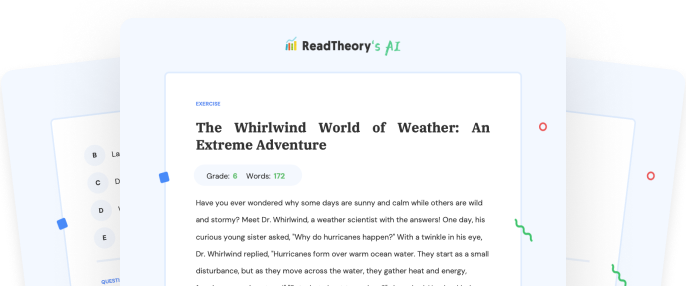Transform Your Teaching
with AI-Powered Worksheets
With ReadTheory’s Instant Worksheet Builder, you can create engaging, grade-appropriate worksheets tailored to your students in minutes. Spark curiosity, save time, and empower critical thinking with AI-powered tools designed for teachers like you.


Transformation of Iran: From the Pahlavi Dynasty to the Islamic Republic
In the early 20th century, Iran was ruled by the Pahlavi Dynasty, with Mohammad Reza Shah being the last reigning monarch. As the Shah, he was known for his ambitious modernization plans and westernization policies, which, while modernizing Iran, also led to widespread discontent due to perceived cultural erosion. By the late 1970s, the dissatisfaction erupted into a revolution. The Iranian Revolution, led by Ayatollah Khomeini, was a significant event that transitioned Iran from a monarchy to an Islamic Republic. This change not only altered Iran's political and social structure but also its relations with other nations, notably the United States and the United Kingdom. The U.S. and U.K. had enjoyed close ties with Iran during the Shah's reign, largely due to strategic oil interests. However, the revolution strained these relationships, leading to decades of tensions that continue to this day. This period of Iran's history serves as an intriguing example of how rapidly a nation's trajectory can shift, shaped by internal dynamics and international politics.
Question 1
Who led the Iranian Revolution in the late 1970s?
Mohammad Reza Shah
Ayatollah Khomeini
Mahatma Gandhi
Nelson Mandela
Fidel Castro
Question 2
What was the result of the Iranian Revolution?
Iran became a democratic republic
Iran became a communist state
Iran became an Islamic Republic
Iran became a monarchy
Iran became a socialist state
Question 3
What was the main cause of discontent among Iranians during the Shah's reign?
His socialist policies
His democratic principles
His westernization policies
His communist ideology
His capitalistic approach
Question 4
What impact did the Iranian Revolution have on Iran's relationship with the U.S. and U.K.?
It strengthened their relationships
It had no impact on their relationships
It strained their relationships
It caused Iran to form alliances with the U.S. and U.K.
It led to Iran becoming a colony of the U.S. and U.K.
Question 5
Which dynasty ruled Iran in the early 20th century?
The Ottoman Dynasty
The Ming Dynasty
The Mughal Dynasty
The Pahlavi Dynasty
The Romanov Dynasty
 or share via
or share via

Assign the ReadTheory pretest to determine students' reading levels.

Why Teachers Love
Instant Worksheet Builder?

Tailored Content for Every Student
Craft worksheets with passages and multiple-choice questions customized to your chosen topic and grade level, ensuring relevance and engagement.

Save Hours
of Prep Time
Our AI, Lexi, generates complete worksheets—passages, questions, and answers—in minutes, freeing you to focus on teaching, not planning.

Standards-Aligned Learning
Every worksheet is designed to boost reading comprehension and critical thinking, aligning seamlessly with State Standards to help your students shine.
Personalized teaching
for personalized learning
Browse worksheets created and refined by educators using Lexi—your source for inspiration and ready-to-use resources.


ReadTheory is free for Teachers to use.
Join thousands of educators using ReadTheory for free. Sign up today and start creating in just minutes!





